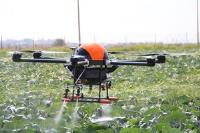 Add My Company
Add My Company
Sign In

Many view the agricultural sector as one of the most traditional and old-fashioned sectors in our modern economy. Whilst it is true that farming has, since the dawn of civilisation to recent times, been largely unchanged. In the last few decades, this has changed dramatically. Modern agriculture uses state-of-the-art technology to drive down operational costs and improve profitability in the sector. Farmers are now turning to a new tool to revolutionise their trade: powerful drones.
One of the key advantages of using an agricultural drone is the ability to carry out detailed analysis of large swathes of land without the need to put expensive feet on the ground to survey crop fields.
Detailed imagery afforded by the camera installed on agricultural drones allows these devices to map large areas, and quickly analyse the crop health of thousands of crops a minute. For manpower to achieve this level of surveillance and analysis of farms would be costly, improving crop yields efficiency by quickly identifying crop faults, allowing the skilled labour to focus on tending to their crops and leaving the top-down observations to the machines.
Agricultural UAVs can capture and process precise information and display such information in an accessible format for farmers to understand and action upon.
Drones can be used for precise spraying, allowing farm technicians to pre-plan intricate routines, ensuring all crops are equally watered to improve yields. Farmers can easily take advantage of the data collected by surveillance drones to directly program sprayers to act on the faults identified. What a neat new pipeline!
It’s not just crop farming that can benefit from drones, as some farmers are using drone technology to manage large fields of livestock. Cameras can track the motion of large herds and infrared sensors can penetrate woodlands and areas of thick undergrowth, whilst GPS sensors can work with fitted collars or tracking chips to create a next generation advanced livestock identification and surveillance system.
Industry commentators are pointing to the use of drones in agriculture as a proponent to the impending “fourth Industrial revolution”, or more trendily known as Industry 4.0: the idea that the use of smart devices and machine to machine communication can create near-complete automation in industrial applications.
Drones in agriculture are a huge driver of this, as the analytical possibilities of fast and nimble drones with advanced monitoring equipment can process and relay data to other machines on farms to create an automated and profitable pipeline to improve farmers’ bottom lines.
Powering these nimble beasts
With the requirement for powerful electric engines driving nimble propellers, industry-grade measurement apparatuses and for operation in harsh weather conditions, it has been a tight conundrum for drone designers to select the right power components for their agricultural drone.
This is where Cincon’s ECLB40W-110 power supply offers its juices to drone makers. With railway certification under its belt – rating it for the necessary shock and vibration resistances needed for drone operation – its small form factor and 40W isolated outputs makes it a perfect fit for a drone.
As for base charging stations, the IP64 Ingress Protection and high power output of IPT of 650W, the Artesyn LCC Series is perfect for outdoor drone charging stations.
Image- Agridrones Solutions Israel - CC BY-SA 4.0
For more information on How drones are being used to make farming “smart” talk to Components Bureau
Enquire Now
More News
List your company on FindTheNeedle.
